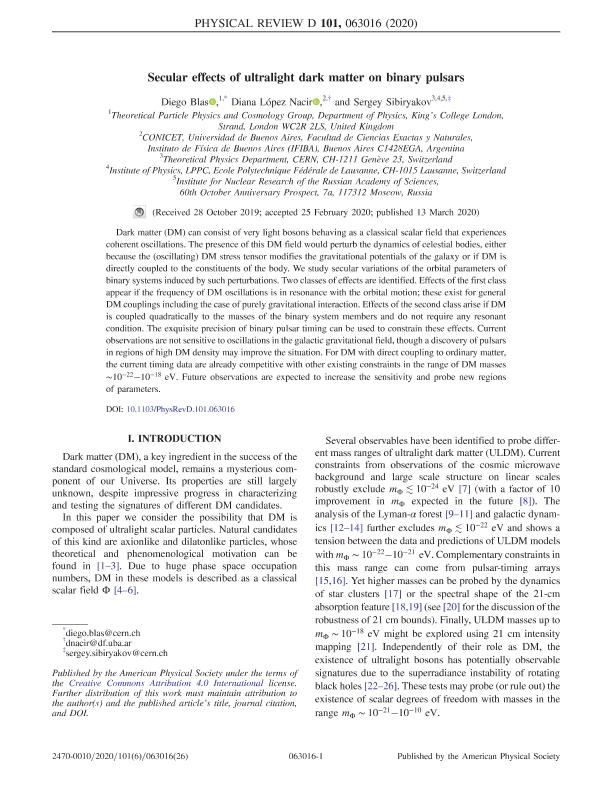Artículo
Secular effects of ultralight dark matter on binary pulsars
Fecha de publicación:
03/2020
Editorial:
American Physical Society
Revista:
Physical Review D: Particles, Fields, Gravitation and Cosmology
ISSN:
1550-7998
Idioma:
Inglés
Tipo de recurso:
Artículo publicado
Clasificación temática:
Resumen
Dark matter (DM) can consist of very light bosons behaving as a classical scalar field that experiences coherent oscillations. The presence of this DM field would perturb the dynamics of celestial bodies, either because the (oscillating) DM stress tensor modifies the gravitational potentials of the galaxy or if DM is directly coupled to the constituents of the body. We study secular variations of the orbital parameters of binary systems induced by such perturbations. Two classes of effects are identified. Effects of the first class appear if the frequency of DM oscillations is in resonance with the orbital motion; these exist for general DM couplings including the case of purely gravitational interaction. Effects of the second class arise if DM is coupled quadratically to the masses of the binary system members and do not require any resonant condition. The exquisite precision of binary pulsar timing can be used to constrain these effects. Current observations are not sensitive to oscillations in the galactic gravitational field, though a discovery of pulsars in regions of high DM density may improve the situation. For DM with direct coupling to ordinary matter, the current timing data are already competitive with other existing constraints in the range of DM masses ∼10-22-10-18 eV. Future observations are expected to increase the sensitivity and probe new regions of parameters.
Palabras clave:
DARK MATTER
,
FIELD THEORY
,
BINARY PULSARS
,
GRAVITY
Archivos asociados
Licencia
Identificadores
Colecciones
Articulos(IFIBA)
Articulos de INST.DE FISICA DE BUENOS AIRES
Articulos de INST.DE FISICA DE BUENOS AIRES
Citación
Blas, Diego; Lopez Nacir, Diana Laura; Sibiryakov, Sergey; Secular effects of ultralight dark matter on binary pulsars; American Physical Society; Physical Review D: Particles, Fields, Gravitation and Cosmology; 101; 6; 3-2020; 1-26
Compartir
Altmétricas




